Berg J.M., Tymoczko J.L., Stryer L. Biochemistry
Подождите немного. Документ загружается.

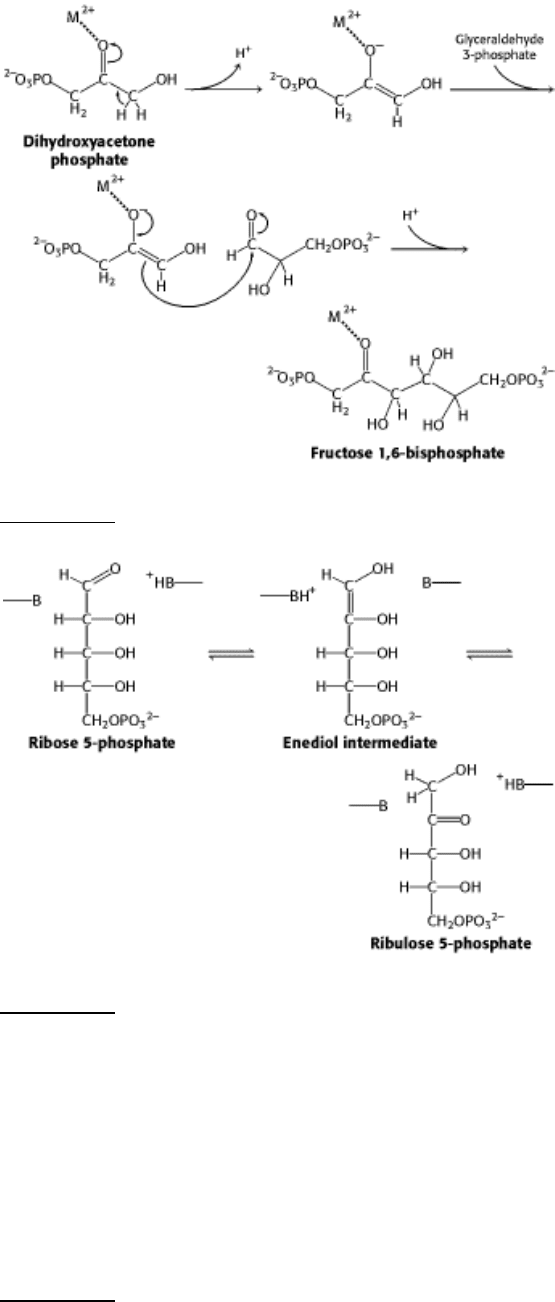
15.
See question
16.
See question
17.
An aliquot of a tissue homogenate is incubated with glucose labeled with
14
C at C-1, and another is incubated with
glucose labeled with
14
C at C-6. The radioactivity of the CO
2
produced by the two samples is then compared. The
rationale of this experiment is that only C-1 is decarboxylated by the pentose phosphate pathway, whereas C-1 and
C-6 are decarboxylated equally when glucose is metabolized by the glycolytic pathway, the pyruvate
dehydrogenase complex, and the citric acid cycle. The reason for the equivalence of C-1 and C-6 in the latter set of
reactions is that glyceraldehyde 3-phosphate and dihydroxyacetone phosphate are rapidly interconverted by triose
phosphate isomerase.
See question

18.
The reduction of each CO
2
to the level of a hexose requires 2 moles of NADPH. The reduction of NADP
+
is a two-
electron process. Hence, the formation of 2 moles of NADPH requires the pumping of four photons by photosystem
I. The electrons given up by photosystem I are replenished by photosystem II, which needs to absorb an equal
number of photons. Hence, eight photons are needed to generate the required NADPH. The energy input of 8 moles
of photons is 381 kcal. Thus, the overall efficiency of photosynthesis under standard conditions is at least 114/381,
or 30%.
See question
19.
(a) The curve on the right was generated by the C
4
plant. Recall that the oxygenase activity of rubisco increases
with temperature more rapidly than does the carboxylase activity. Consequently, at higher temperatures, the C
3
plants would fix less carbon. Because C
4
plants can maintain a higher CO
2
concentration, the rise in temperature is
less deleterious.
(b) The oxygenase activity will predominate. Additionally, when the temperature rise is very high, evaporation of
water might become a problem. The higher temperatures can begin to damage protein structures as well.
(c) The C
4
pathway is a very effective active-transport system for concentrating CO
2
, even when environmental
concentrations are very low.
(d) With the assumption that the plants have approximately the same capability to fix CO
2
, the C
4
pathway is
apparently the rate-limiting step in C
4
plants.
See question
Answers to Problems
Chapter 21
1.
Galactose + ATP + UTP + H
2
O + glycogen
n
glycogen
n
+1
+ ADP + UDP + 2 P
i
+ H
+
See question
2.
As an unbranched polymer, α-amylose has only one nonreducing end. Therefore, only one glycogen phosphorylase
molecule could degrade each α-amylose molecule. Because glycogen is highly branched, there are many
nonreducing ends per molecule. Consequently, many phosphorylase molecules can release many glucose molecules
per glycogen molecule.
See question
3.
The patient has a deficiency of the branching enzyme.
See question
4.
The high level of glucose 6-phosphate in von Gierke disease, resulting from the absence of glucose 6-phosphatase or
the transporter, shifts the allosteric equilibrium of phosphorylated glycogen synthase toward the active form.
See question

5.
Glucose is an allosteric inhibitor of phosphorylase a. Hence, crystals grown in its presence are in the T state. The
addition of glucose 1-phosphate, a substrate, shifts the R T equilibrium toward the R state. The conformational
differences between these states are sufficiently large that the crystal shatters unless it is stabilized by chemical cross-
links.
See question
6.
The phosphoryl donor is glucose 1,6-bisphosphate, which is formed from glucose 1-phosphate and ATP in a reaction
catalyzed by phosphoglucokinase.
See question
7.
Water is excluded from the active site to prevent hydrolysis. The entry of water could lead to the formation of
glucose rather than glucose 1-phosphate. A site-specific mutagenesis experiment is revealing in this regard. In
phosphorylase, Tyr 573 is hydrogen bonded to the 2
-OH of a glucose residue. The ratio of glucose 1-phosphate to
glucose product is 9000:1 for the wild-type enzyme, and 500:1 for the Phe 573 mutant. Model building suggests that
a water molecule occupies the site normally filled by the phenolic OH of tyrosine and occasionally attacks the
oxocarbonium ion intermediate to form glucose.
See question
8.
The amylase activity was necessary to remove all of the glycogen from the glycogenin. Recall that glycogenin
synthesizes oligosaccharides of about eight glucose units, and then activity stops. Consequently, if the glucose
residues are not removed by extensive amylase treatment, glycogenin would not function.
See question
9.
The substrate can be handed directly from the transferase site to the debranching site.
See question
10.
During exercise, [ATP] falls and [AMP] rises. Recall that AMP is an allosteric activator of glycogen phosphorylase
b. Thus, even in the absence of covalent modification by phosphorylase kinase, glycogen is degraded.
See question
11.
(a) Muscle phosphorylase b will be inactive even when the AMP level is high. Hence, glycogen will not be
degraded unless phosphorylase is converted into the a form by hormone-induced or Ca
2+
-induced phosphorylation.
(b) Phosphorylase b cannot be converted into the much more active a form. Hence, the mobilization of liver
glycogen will be markedly impaired.
(c) The elevated level of the kinase will lead to the phosphorylation and activation of glycogen phosphorylase.
Because glycogen will be persistently degraded, little glycogen will be present in the liver.
(d) Protein phosphatase 1 will be continually active. Hence, the level of phosphorylase b will be higher than
normal, and glycogen will be less readily degraded.
(e) Protein phosphatase 1 will be much less effective in dephosphorylating glycogen synthase and glycogen
phosphorylase. Consequently, the synthase will stay in the less active b form, and the phosphorylase will stay in the
more active a form. Both changes will lead to increased degradation of glycogen.

(f) The absence of glycogenin will block the initiation of glycogen synthesis. Very little glycogen will be
synthesized in its absence.
See question
12.
(a) The α subunit is thus always active. cAMP is always produced. Glycogen degradation always occurs, and
glycogen synthesis is always inhibited.
(b) Glycogen phosphorylase cannot be covalently activated. Glycogen degradation is always inhibited; nothing can
remain phosphorylated. Glycogen synthesis is always active; nothing can remain phosphorylated.
(c) Phosphodiesterase destroys cAMP. Therefore, glycogen degradation would always be active and glycogen
synthesis would always be inhibited.
See question
13.
The slow phosphorylation of the α subunits of phosphor-ylase kinase serves to prolong the degradation of
glycogen. The kinase cannot be deactivated until its α subunits are phosphorylated. The slow phosphorylation of α
subunits ensures that the kinase and, in turn, phosphorylase stay active for an extended interval.
See question
14.
Phosphorylation of the β subunit activates the kinase and leads to glycogen degradation. Subsequent
phosphorylation of the α subunit make the β subunit and the α subunit substrates for protein phosphatase. Thus, if
the α subunit were modified before the β subunit, the enzyme would be primed for shutdown before it was
activated and little glycogen degradation would take place.
See question
15.
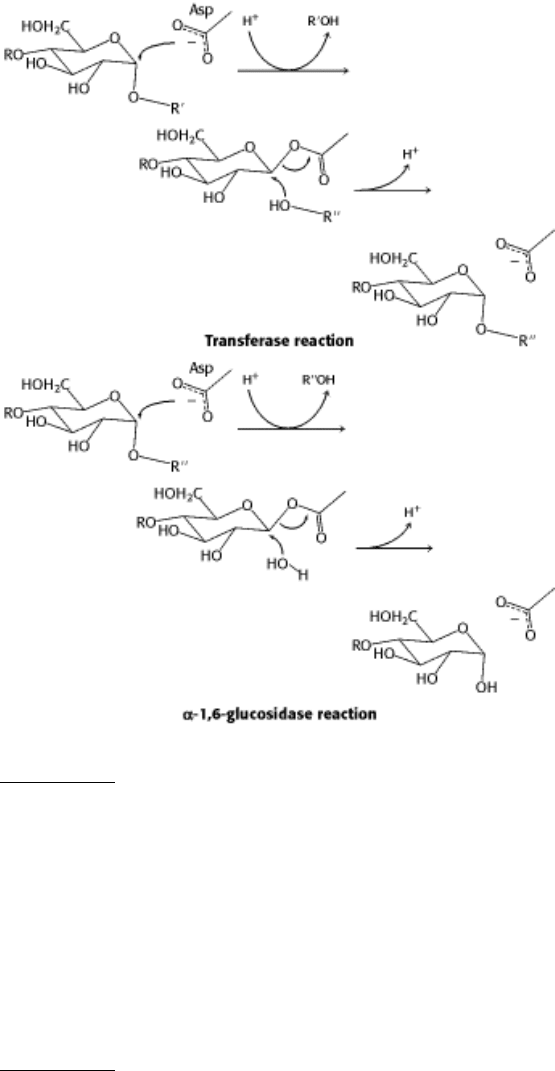
See question
16.
(a) The glycogen was too large to enter the gel and, because analysis was by Western blot with the use of an
antibody specific to glycogenin, one would not expect to see background proteins.
(b) α-Amylase degrades glycogen, releasing the protein glycogenin so that it can be visualized by the Western blot.
(c) Glycogen phosphorylase, glycogen synthase, and protein phosphatase 1. These proteins might be visible if the
gel were stained for protein, but a Western analysis reveals the presence of glycogenin only.
See question
17.
(a) The smear was due to molecules of glycogenin with increasingly large amounts of glycogen attached to them.
(b) In the absence of glucose in the medium, glycogen is metabolized, resulting in a loss of the high-molecular-
weight material.
(c) Glycogen could be resynthesized and added to the glycogenin when the cells were fed glucose again.
(d) No difference between lanes 3 and 4 suggests that, by 1 hour, the glycogen molecules had attained maximum
size in this cell line. Prolonged incubation does not apparently increase the amount of glycogen.
(e) α-Amylase removes essentially all of the glycogen, and so only the glycogenin remains.
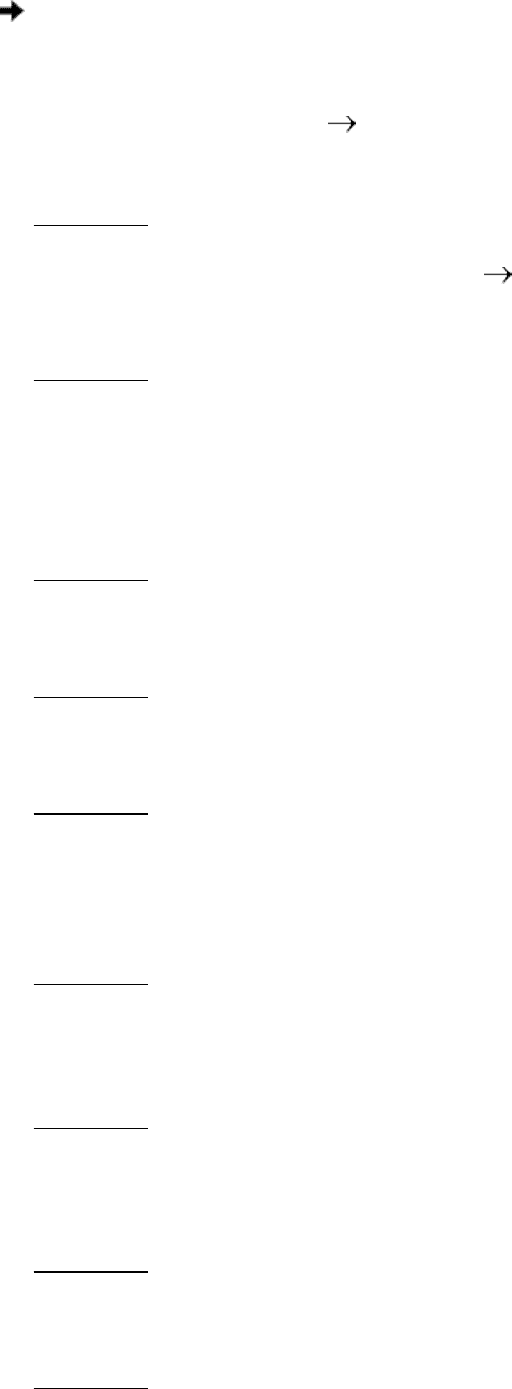
Answers to Problems
Chapter 22
1.
Glycerol + 2 NAD
+
+ P
i
+ ADP pyruvate + ATP + H
2
O + 2 NADH + H
+
Glycerol kinase and glycerol
phosphate dehydrogenase.
See question
2.
Stearate + ATP + 13
1
/
2
H
2
O + 8 FAD + 8 NAD
+
4
1
/
2
acetoacetate + 14
1
/
2
H
+
+ 8 FADH
2
+ 8 NADH + AMP +
2 P
i
See question
3.
(a) Oxidation in mitochondria; synthesis in the cytosol. (b) Acetyl CoA in oxidation; acyl carrier protein for
synthesis. (c) FAD and NAD
+
in oxidation; NADPH for synthesis. (d) l isomer of 3-hydroxyacyl CoA in oxidation; d
isomer in synthesis. (e) From carboxyl to methyl in oxidation; from methyl to carboxyl in synthesis. (f) The enzymes
of fatty acid synthesis, but not those of oxidation, are organized in a multienzyme complex.
See question
4.
(a) Palmitoleate; (b) linoleate; (c) linoleate; (d) oleate; (e) oleate; (f) linolenate.
See question
5.
C-1 is more radioactive.
See question
6.
Decarboxylation drives the condensation of malonyl ACP and acetyl ACP. In contrast, the condensation of two
molecules of acetyl ACP is energetically unfavorable. In gluconeogenesis, decarboxylation drives the formation of
phosphoenolpyruvate from oxaloacetate.
See question
7.
Adipose-cell lipase is activated by phosphorylation. Hence, overproduction of the cAMP-activated kinase will lead
to an accelerated breakdown of triacylglycerols and a depletion of fat stores.
See question
8.
The mutant enzyme would be persistently active because it could not be inhibited by phosphorylation. Fatty acid
synthesis would be abnormally active. Such a mutation might lead to obesity.
See question
9.
Carnitine translocase deficiency and glucose 6-phosphate transporter deficiency.
See question

10.
In the fifth round of β oxidation, cis-∆
2
-enoyl CoA is formed. Dehydration by the classic hydratase yields d-3-
hydroxyacyl CoA, the wrong isomer for the next enzyme in β oxidation. This dead end is circumvented by a second
hydratase that removes water to give trans-∆
2
-enoyl CoA. The addition of water by the classic hydratase then
yields l-3- hydroxyacyl CoA, the appropriate isomer. Thus, hydratases of opposite stereospecificities serve to
epimerize (invert the configuration of) the 3-hydroxyl group of the acyl CoA intermediate.
See question
11.
The probability of synthesizing an error-free polypeptide chain decreases as the length of the chain increases. A
single mistake can make the entire polypeptide ineffective. In contrast, a defective subunit can be spurned in
forming a noncovalent multienzyme complex; the good subunits are not wasted.
See question
12.
The absence of ketone bodies is due to the fact that the liver, the source of blood-ketone bodies, cannot oxidize
fatty acids to produce acetyl CoA. Moreover, because of the impaired fatty acid oxidation, the liver becomes more
dependent on glucose as an energy source. This dependency results in a decrease in gluconeogenesis and a drop in
blood-glucose levels, which is exacerbated by the lack of fatty acid oxidation in muscle and a subsequent increase
in glucose uptake from the blood.
See question
13.
Peroxisomes enhance the degradation of fatty acids. Consequently, increasing the activity of peroxisomes could
help to lower levels of blood triacylglycerides. In fact, clofibrate is rarely used because of serious side effects.
See question
14.
Citrate works by facilitating the formation of active filaments from inactive monomers. In essence, it increases the
number of active sites available, or the concentration of enzyme. Consequently, its effect is visible as an increase in
the value of V
max
. Allosteric enzymes that alter their V
max
values in response to regulators are sometimes called V-
class enzymes. The more common type of allosteric enzyme, in which K
m
is altered, comprises K-class enzymes.
Palmitoyl CoA causes depolymerization and thus inactivation.
See question
15.
The thiolate anion of CoA attacks the 3-keto group to form a tetrahedral intermediate. This collapses to form acyl
CoA and the enolate anion of acetyl CoA. Protonation of the enolate yields acetyl CoA.
See question
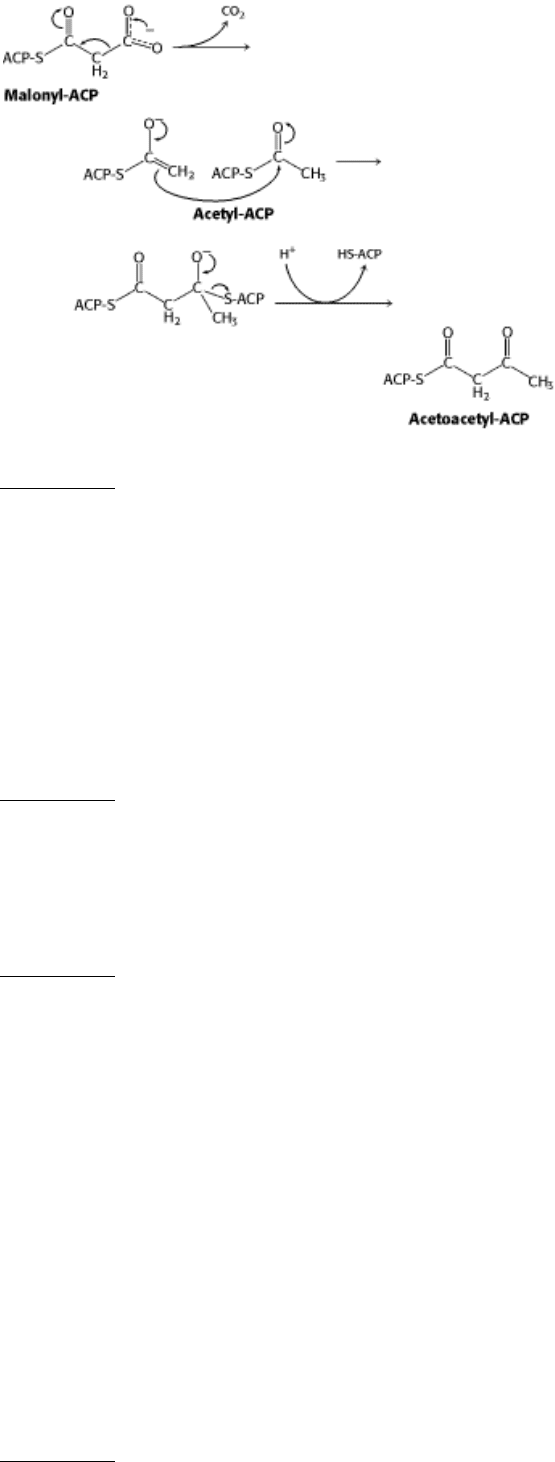
16.
See question
17.
(a) Fats burn in the flame of carbohydrates. Without carbohydrates, there would be no anapleurotic reactions to
replenish the TCA-cycle components. With a diet of fats only, the acetyl CoA from fatty acid degradation would
build up.
(b) Acetone from ketone bodies.
(c) Yes. Odd-chain fatty acids would lead to the production of propionyl CoA, which can be converted into
succinyl CoA, a TCA-cycle component. It would serve to replenish the TCA cycle and mitigate the halitosis.
See question
18.
A labeled fat can enter the citric acid cycle as acetyl CoA and yield labeled oxaloacetate, but only after two carbon
atoms have been lost as CO
2
. Consequently, even though oxaloacetate may be labeled, there can be no net synthesis
in the amount of oxaloacetate and hence no net synthesis of glucose or glycogen.
See question
19.
(a) The V
max
is decreased and the K
m
is increased. V
max
(wild type) = 13 nmol minute
-1
mg
-1
; K
m
(wild type) =
45 µM; V
max
(mutant) = 8.3 nmol minute
-1
mg
-1
; K
m
(mutant) = 74 µM.
(b) Both the V
max
and the K
m
are decreased. V
max
(wild type) = 41 nmol minute
-1
mg
-1
; K
m
(wild type) = 104
µM; V
max
(mutant) = 23 nmol minute
-1
mg
-1
; K
m
(mutant) = 69 µM.
(c) The wild type is significantly more sensitive to malonyl CoA.
(d) With respect to carnitine, the mutant displays approximately 65% of the activity of the wild type; with respect
to palmitoyl CoA, approximately 50% activity. On the other hand, 10 µM of malonyl CoA inhibits approximately
80% of the wild type but has essentially no effect on the mutant enzyme.
(e) The glutamate appears to play a more prominent role in regulation by malonyl CoA than in catalysis.
See question
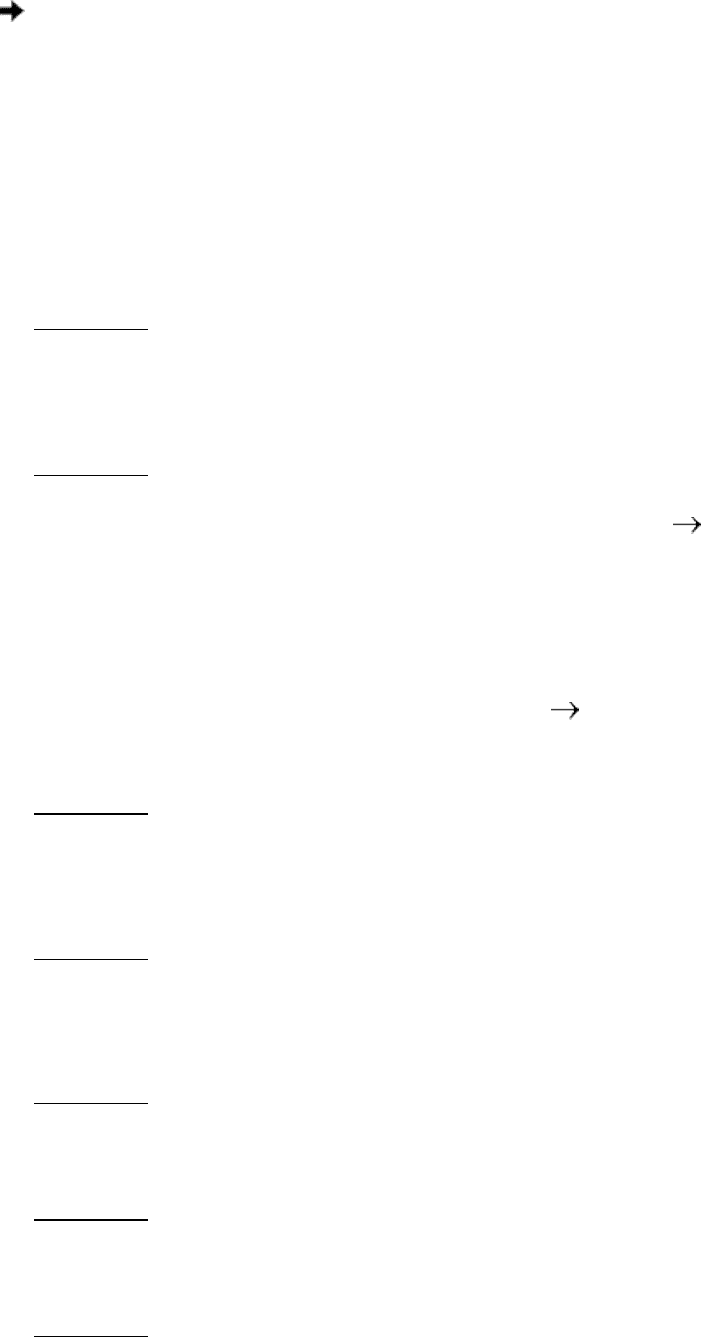
Answers to Problems
Chapter 23
1.
(a) The ATPase activity of the 26S proteasome resides in the 19S subunit. The energy of ATP hydrolysis could be
used to unfold the substrate, which is too large to enter the catalytic barrel. ATP may also be required for
translocation of the substrate into the barrel.
(b) Substantiates the answer in part a. Because they are small, the peptides do not need to be unfolded. Moreover,
small peptides could probably enter all at once and not require translocation.
See question
2.
(a) Pyruvate; (b) oxaloacetate; (c) α-ketoglutarate; (d) α-ketoisocaproate; (e) phenylpyruvate; (f) hydroxyphenyl-
pyruvate.
See question
3.
(a) Aspartate + α-ketoglutarate + GTP + ATP + 2 H
2
O + NADH + H
+
1
/
2
glucose + glutamate + CO
2
+ ADP +
GDP + NAD
+
+ 2 P
i
The required coenzymes are pyridoxal phosphate in the transamination reaction and NAD
+
/NADH in the redox
reactions.
(b) Aspartate + CO
2
+ NH
4
+
+ 3 ATP + NAD
+
+ 4 H
2
O oxaloacetate + urea + 2 ADP + 4 P
i
+ AMP + NADH +
H
+
See question
4.
In the eukaryotic proteasome, the distinct β subunits have different substrate specificities, allowing proteins to be
more thoroughly degraded.
See question
5.
The six subunits probably exist as a heterohexamer. Cross-linking experiments could test the model and help
determine which subunits are adjacent to one another.
See question
6.
Thiamine pyrophosphate.
See question
7.
It acts as an electron sink.
See question

8.
CO
2
+ NH
4
+
+ 3 ATP + NAD
+
+ aspartate + 3 H
2
O urea + 2 ADP + 2 P
i
+ AMP + PP
i
+ NADH + H
+
+
oxaloacetate
Four high-transfer-potential groups are spent.
See question
9.
Ornithine transcarbamoylase (analogous to PALA; see Chapter 10).
See question
10.
Ammonia could lead to the amination of α-ketoglutarate, producing a high concentration of glutamate in an
unregulated fashion. α-Ketoglutarate for glutamate synthesis could be removed from the citric acid cycle, thereby
diminishing the cell's respiration capacity.
See question
11.
The mass spectrometric analysis strongly suggests that three enzymes
pyruvate dehydrogenase, α-ketoglutarate
dehydrogenase, and the branched-chain α-keto dehydrogenase are deficient. Most likely, the common E
3
component of these enzymes is missing or defective. This proposal could be tested by purifying these three
enzymes and assaying their ability to catalyze the regeneration of lipoamide.
See question
12.
Benzoate, phenylacetate, and arginine would be given to supply a protein-restricted diet. Nitrogen would emerge in
hippurate, phenylacetylglutamine, and citrulline.
See question
13.
Aspartame, a dipeptide ester (l-aspartyl-l-phenylalanine methyl ester), is hydrolyzed to l-aspartate and l-
phenylalanine. High levels of phenylalanine are harmful in phenylketonurics.
See question
14.
N-Acetylglutamate is synthesized from acetyl CoA and glutamate. Once again, acetyl CoA serves as an activated
acetyl donor. This reaction is catalyzed by N-acetylglutamate synthase.
See question
15.
See equation below.
